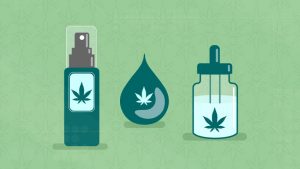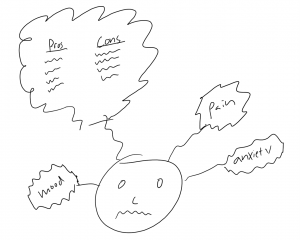
Your family might not be like my family. At Thanksgiving, In between the catching up on how school and work is, an interesting conversation came up between us. My Aunt and Uncle began talking about CBD, and how it’s helped them for a variety of ailments, including one specific issue they’d been having. Turns out their dog has an intense fear of storms, and CBD lotion seems to alleviate that fear. I personally couldn’t imagine giving my dog CBD, but this example does speak to just how wide a range for use the general public see for CBD. Indeed, it has been suggested that CBD and medical marijuana can offer help in a variety of conditions, all the way from anxiety to pain.
Neurochemical Mechanisms
As it turns out, there is specific neurochemical evidence to support that the human endocannabinoid system, which is stimulated by things like medical marijuana and CBD, can be leveraged to alleviate all types of distressing symptoms. This is due, in part, to the fact that the endocannabinoid system is self-regulating. As a certain signal increases, pain for example, a neuron that receiving excessive pain signals, can signal to the neuron that sent the initial signal to just chill just a bit. This method of self-regulation can be extremely helpful, especially in situation where excessive cell signaling is taking place such as in anxiety and pain. The way this retroactive signaling takes place is only somewhat understood. We know the endocannabinoid systems activates a vast array of downstream signaling cascades within cells, but not all their functions are fully understood. Considering both the function and widespread availability of endocannabinoids, the science supports the proposed healing effects put forth by an abundance of experimental and anecdotal evidence. In fact, the CB1 endocannabinoid receptor is one of the most largely expressed in the entire central nervous system! It makes sense that it could help a variety of ailments, even those that seem they couldn’t possibly be related.
Miracle Drug?
When considering CBD and medical marijuana, I have even heard the term “miracle drug” thrown around due to both it’s efficacy, and range in use. Now, for the rest of this blog, I will make no attempt to hide my own biases and opinions. I’m a psych guy. I tend to view issues through a psychological perspective, one which involves avoiding the use of pharmacological options until it is absolutely clear their benefit outweighs their risk. Indeed, every intervention, in my opinion, should be viewed in this way. A provider should only pull out the pen to write the script when the dangers/discomfort of an ailment clearly less of a risk than the condition itself. Any pill or injection is an unnatural means for chemical agents to enter the body. Regarding taking Ibuprofen for a headache, the risk is low and the benefit can be great, so taking it makes all the sense in the world. When issuing chemotherapy for cancer, the risk of cancer far outweighs that of chemo in nearly all scenarios, despite the brutal side effects. Now, the water begins to get murky when thinking of diseases typically associated with the treatment of medical marijuana and CBD. For the sake of this blog, I am going to focus on chronic pain and anxiety.

Artstract by Ben Swanson
As a society, we tend to look for the next drug to alleviate suffering, almost as if it is the only option. Alleviating suffering is indeed a positive thing, and every opportunity to research CBD and medical marijuana should be taken because the opportunities for replacing opioids and benzodiazepines for treatments are impressive. However, as with chronic pain and anxiety, and other disorders CBD and medical marijuana is typically used for, these things usually aren’t going to do serious bodily harm. Cause distress? Absolutely. Impact quality of life? Certainly. These things should certainly be addressed, but they should be done so when looking at the risks and benefits of taking CBD and weed. Now I can guess what you’re thinking…
”Come on Ben, this is a natural substance that comes from plants. This is a lot safer than other stuff we put in our bodies that get prescribed. You’re fear mongering about a relatively harmless drug that millions have found helpful.”
Word of Caution
What I would say is this; we don’t really know that. On initial inspection, it sure seems that way when CBD and marijuana is less harmful compared to other drugs used to treat anxiety and pain. However, the reality is that we do not have the scientific data to support that assumption. The exact mechanisms for CBD are not well understood, and because it is so widespread in the CNS, I fear we have jumped the gun on CBD and medical marijuana. What is someone going to look like after 20 years of taking CBD? What kind of effects will this have in the CNS and it’s ability to regulate itself? Could CBD be addictive long term? The fact is, there are no answers to these questions because the research does not yet exist. Should it exist? Absolutely. There will be a flood of research in coming years examining these very questions. But without this research, I hope providers and consumers alike are weighing the risk benefit of CBD and medical marijuana. I hope people ask themselves, is this something I really NEED? Or is this something that I think I need. Do the risks of not fully understanding this drug, truly outweigh the treatment benefits? The possibilities behind medical marijuana and CBD are exciting, and I’m going to be thrilled if they truly are a less harmful substituted for some common ailments. However, right now I am cautiously optimistic, and believe more research is needed before we can coin this the “miracle drug”.